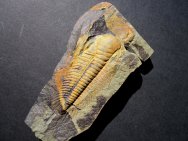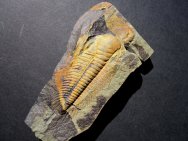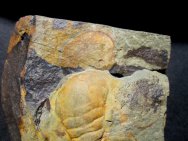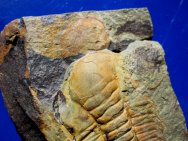 Description:
Presented is an unusual association plate from the Barrandian of
the Czech Republic. The Paradoxides is mid-sized and in good condition,
though missing its free cheeks. The more intriguing specimen is
the Forfexicaris sp. It’s an unusual and odd arthropod. I
have never encountered one before, and obviously, never one from
all of the hundreds of Czech trilobites that have passed over my
desk. Description:
Presented is an unusual association plate from the Barrandian of
the Czech Republic. The Paradoxides is mid-sized and in good condition,
though missing its free cheeks. The more intriguing specimen is
the Forfexicaris sp. It’s an unusual and odd arthropod. I
have never encountered one before, and obviously, never one from
all of the hundreds of Czech trilobites that have passed over my
desk.
Forfexicaris valida was an egg-shaped nektonic predatory arthropod
also known from the Lower Cambrian Maotianshan shale Lagerstätte
about 1.5 centimetres long. This creature bears a superficial resemblance
to ostracod crustaceans, though, F. valida is not considered to
be an ostracod, nor even a crustacean due to its leg morphology.
Like its relative, Occacaris oviformis, F. valida also had a pair
of "great appendages," though, it did not have paired
spines. Unlike O. oviformis, F. valida's trunk did not extend beyond
its carapace.
There are more that 1300 described species of Barrandian
trilobites. An amazing statistic when you consider the area collected
is only a few hundred square miles. Bohemia is the historical name
given to the area of central Czech Republic where these species
are found. Barrandian trilobites refer to the trilobite fauna found
here. The term comes from the seminal work done by the J. Barrnade
(1799-1883) who spent over half his life describing these trilobites
and helping establish the science of paleontology. He himself described
over 300 species. Bohemian trilobites are found in the Middle, and
Upper Cambrian, Ordovician, Silurian and Devonian Periods. They
have been studied and collected since the mid 1700's. Their quality
of preservation, variety and scientific importance has made them
most collectable ever since.
|



